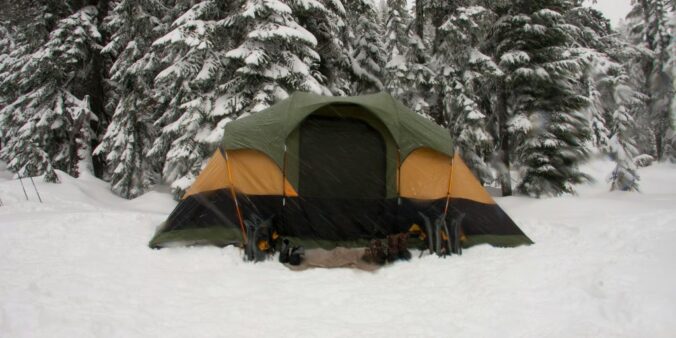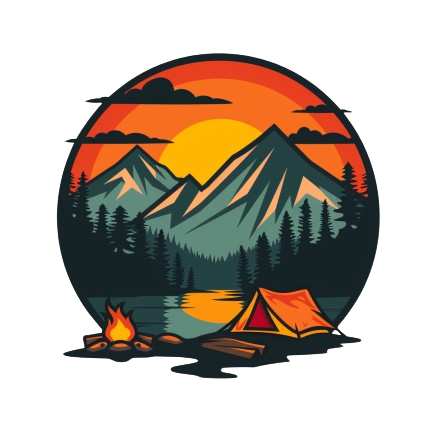Winter camping has its perks. There are fewer bugs and crowds while you experience the beauty and peacefulness of a pristine winter wonderland. But, if you’re not prepared, it can also be cold and challenging. To set yourself up for a successful winter campout, you’ll want to build on your knowledge of fair-weather camping while adjusting for the additional challenges of cold temperatures, snowy landscapes, and unpredictable weather.
Key Takeaways
- Ensure you have the right gear, including a sturdy tent, warm sleeping bag, and appropriate clothing layers to stay warm and comfortable.
- Create a comprehensive checklist that includes portable stoves, cookware, camping meals, and lighting options to ensure you don’t forget essential items.
- Select a campsite that is sheltered from the wind and free from avalanche danger, and prepare your tent site by packing down the snow.
- Stay hydrated and consume nutritious, high-calorie meals to maintain your energy levels and help keep your body warm.
- Follow safety tips to prevent frostbite and hypothermia, and be prepared for emergencies by knowing basic first aid and carrying necessary supplies.
Essential Winter Camping Gear

Winter camping can be a magical experience, but it requires the right camping gear to ensure you stay warm, dry, and comfortable. Here’s a guide to help you choose the essential items for your next winter adventure.
Choosing the Right Tent and Sleeping Bag
When it comes to winter camping, your tent and sleeping bag are your primary defenses against the cold. Look for a four-season tent that can withstand heavy snow and strong winds. Your sleeping bag should be rated for temperatures well below freezing. Don’t forget to bring a sleeping pad with high insulation value to keep the cold ground from sapping your body heat.
Must-Have Clothing and Accessories
Staying warm is all about layering. Start with a moisture-wicking base layer, add an insulating mid-layer, and top it off with a waterproof and windproof outer layer. Essential accessories include warm socks, a hat, gloves, and a scarf. Sunglasses and sunscreen are also important to protect against the sun’s glare off the snow.
Portable Heaters and Lighting Options
Portable heaters can make a big difference in your comfort level. Choose a heater that’s safe for indoor use and has an automatic shut-off feature. For lighting, headlamps and lanterns are essential. Make sure to bring extra batteries or a solar charger to keep your devices powered.
Preparation is key: planning your winter camping trip starts with having the right gear. From durable snowshoes to reliable snow sleds, get the gear that’ll make your winter escapade a joyous experience for the whole family.
Planning Your Winter Camping Trip
Creating a Checklist
The planning starts NOW! Preparation is key: planning your winter camping trip. Once you’ve made that decision to embark on a winter wonderland escape, take a trip to Ocean State Job Lot to start your preparations. You can bank on the temperatures dropping as the days turn into night, but we can keep you warm with all of our warm essentials.
Selecting the Perfect Campsite
Winter camping has its perks. There are fewer bugs and crowds while you experience the beauty and peacefulness of a pristine winter wonderland. But, if you’re not prepared, it can also be cold and challenging. To set yourself up for a successful winter campout, you’ll want to build on your knowledge of fair-weather camping while adjusting for the additional challenges of cold temperatures, snowy landscapes and unpredictable weather.
Weather Considerations
While the weather may look nice with its glistening, snowy landscape and crisp, cool air, you’re going to want to make sure you have a plan for the following, in addition to those items listed above:
- Portable stoves
- Cookware sets
- Camping meals
- Lanterns and headlamps
Having that checklist will definitely help when purchasing your products and packing the car or truck before your trip.
Staying Warm and Comfortable

The trick to staying comfortable outdoors during winter is to remain warm and dry. To do this, you need to regulate your body temperature so that you’re never too hot and sweaty, and never so cold that your core body temperature drops. The most efficient way to regulate your temperature is to dress in layers so that you can quickly add or remove clothing.
Basically, there are three layers you should carry:
- Base Layer: This layer is designed to wick moisture away from your skin. Look for materials like merino wool or synthetic fabrics.
- Insulating Layer: This layer traps body heat to keep you warm. Fleece or down jackets are excellent choices.
- Outer Layer: This layer protects you from wind, rain, and snow. A good waterproof and windproof jacket is essential.
Your sleeping area is your sanctuary in the cold. Start with a high-quality sleeping bag rated for winter temperatures. Adding a sleeping pad underneath your sleeping bag will provide insulation from the cold ground. Consider using a tent with a smaller footprint to retain heat more effectively.
A well-insulated sleeping area can make the difference between a restful night and a cold, uncomfortable one.
Portable heaters can be a game-changer for winter camping. However, it’s crucial to use them safely. Always follow the manufacturer’s guidelines and never leave a heater unattended. Ventilation is key to prevent carbon monoxide buildup. Battery-operated heaters are a safer option compared to fuel-based ones.
By following these tips, you can ensure that your winter camping adventure is both warm and comfortable.
Winter Camping Nutrition

Hearty Breakfast Ideas
Start your day with a hearty breakfast featuring energy-packed options like oatmeal, granola, and hot beverages like coffee. That will get your body kick-started to a warm and healthy beginning no matter what the plans for your day include.
Nutritious Snacks and Meals
For daytime snacks, pack nuts, trail mix, and high-energy bars to maintain stamina. Consider quick and nutrient-rich options like dried fruits and jerky to keep you fueled during activities in the crisp winter air. Enjoy hot and simple meals: A hot meal while winter camping is especially gratifying, but try to keep your meals simple so you’re not stuck cleaning lots of dishes in the cold. Consider calorie-dense foods that don’t take much time to cook and look for one-pot options. Freeze-dried entrees and breakfast foods are also good choices.
Staying Hydrated in Cold Weather
Your body uses a lot of energy when you’re trekking through cold, snowy landscapes. It’s important to eat and hydrate well before, during, and after your activity so you can keep your energy up and stay warm. Be sure to hydrate throughout the day.
Proper nutrition and hydration will help you stay warm. Make hot, nutritious breakfasts and dinners and enjoy quick snacks and lunches.
Safety Tips for Winter Camping
Preventing Frostbite and Hypothermia
Frostbite and hypothermia are serious risks when camping in winter. Always keep an eye on your extremities and ensure they are well-protected. Wear insulated gloves, thick socks, and a hat to minimize exposure. If you notice any numbness or discoloration, take immediate action to warm the affected area.
Avalanche Safety
When camping in snowy regions, it’s crucial to be aware of avalanche risks. Check the local avalanche forecast before your trip and avoid camping in areas with steep slopes. Carry essential avalanche safety gear, such as a beacon, probe, and shovel, and know how to use them. Remember, your campsite should be sheltered from the wind and free of avalanche danger.
Emergency Preparedness
Being prepared for emergencies is a key aspect of winter camping. Pack a well-stocked first aid kit, a multi-tool, and a reliable communication device. It’s also wise to inform someone about your camping plans and expected return time. In case of an emergency, having a plan can make all the difference.
Winter camping can be a thrilling adventure, but safety should always come first. By following these camp tips, you can ensure a safe and enjoyable experience.
Fun Activities for Winter Camping

Winter camping offers a unique opportunity to explore a variety of things to do while camping in winter, from snowshoeing to stargazing, to make your cold-weather adventure unforgettable. Here are some fun activities to keep you entertained and make the most of your winter camping experience.
Snowshoeing and Hiking
Snowshoeing and hiking are fantastic ways to explore the snowy landscape. With the right gear, you can traverse through snow-covered trails and enjoy the serene beauty of winter. Don’t forget to pack your snowshoes and hiking poles for a safe and enjoyable trek.
Building a Snow Shelter
Building a snow shelter can be both a fun and practical activity. Whether you create a simple snow cave or an elaborate igloo, this activity not only provides shelter but also a sense of accomplishment. It’s a great way to learn some essential camp hacks for winter survival.
Campfire Stories and Games
Stay entertained during the frosty nights with a selection of board games and portable entertainment devices, ensuring laughter and joy around the campfire. It also might be the perfect way to wind down after an eventful day outdoors.
Embrace the beauty of winter camping by engaging in these fun activities, making your trip both enjoyable and memorable.
Winter camping can be an exhilarating experience filled with unique activities like snowshoeing, ice fishing, and building snow shelters. To make the most of your winter adventure, visit our website for more tips and tricks!
Conclusion
Winter camping can be an exhilarating and rewarding experience, offering a unique way to enjoy the serene beauty of snowy landscapes. By carefully planning and preparing with the right gear, you can ensure a safe and enjoyable adventure. Don’t forget to explore a variety of portable heaters, cookware, and lighting options to create a comfortable and inviting campsite atmosphere. From durable snowshoes to reliable snow sleds, get the gear that’ll make your winter escapade a joyous experience for the whole family. Remember, preparation is key, so start planning now and make the most of your winter camping adventure!
Frequently Asked Questions
What type of tent is best for winter camping?
A four-season tent is best for winter camping as it is designed to withstand heavy snow and strong winds. Look for features like sturdy poles, a robust rainfly, and good ventilation.
How can I stay warm while sleeping in a tent during winter?
Layer your clothing, use a high-quality sleeping bag rated for low temperatures, and consider using two sleeping pads for extra insulation from the cold ground. Additionally, portable heaters can be used safely if they are designed for indoor use.
What are some essential clothing items for winter camping?
Essential clothing items include midweight base layers, fleece pants, a puffy coat, waterproof jacket and pants, warm socks, a hat, gloves, and sunglasses. Layering is crucial to stay warm and comfortable.
How do I prevent frostbite and hypothermia while winter camping?
To prevent frostbite and hypothermia, keep your body dry and warm by wearing appropriate clothing, staying hydrated, and eating high-calorie foods. Avoid prolonged exposure to the cold and wind, and monitor for symptoms such as numbness or shivering.
What should I include in my winter camping checklist?
Your winter camping checklist should include a four-season tent, a sleeping bag rated for low temperatures, sleeping pads, portable stoves, cookware sets, camping meals, lanterns and headlamps, warm clothing, first aid kit, and emergency supplies.
How can I stay hydrated in cold weather?
Staying hydrated in cold weather is essential. Drink plenty of water throughout the day, and consider warm beverages like tea or hot chocolate. Use insulated bottles to prevent your water from freezing.


Leave a Reply